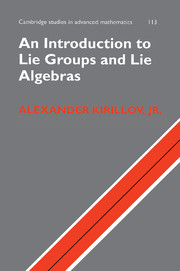Book contents
- Frontmatter
- Contents
- Preface
- 1 Introduction
- 2 Lie groups: basic definitions
- 3 Lie groups and Lie algebras
- 4 Representations of Lie groups and Lie algebras
- 5 Structure theory of Lie algebras
- 6 Complex semisimple Lie algebras
- 7 Root systems
- 8 Representations of semisimple Lie algebras
- Overview of the literature
- Appendix A Root systems and simple Lie algebras
- Appendix B Sample syllabus
- List of notation
- Bibliography
- Index
1 - Introduction
Published online by Cambridge University Press: 31 May 2010
- Frontmatter
- Contents
- Preface
- 1 Introduction
- 2 Lie groups: basic definitions
- 3 Lie groups and Lie algebras
- 4 Representations of Lie groups and Lie algebras
- 5 Structure theory of Lie algebras
- 6 Complex semisimple Lie algebras
- 7 Root systems
- 8 Representations of semisimple Lie algebras
- Overview of the literature
- Appendix A Root systems and simple Lie algebras
- Appendix B Sample syllabus
- List of notation
- Bibliography
- Index
Summary
In any algebra textbook, the study of group theory is usually mostly concerned with the theory of finite, or at least finitely generated, groups. This is understandable: such groups are much easier to describe. However, most groups which appear as groups of symmetries of various geometric objects are not finite: for example, the group SO(3, ℝ) of all rotations of three-dimensional space is not finite and is not even finitely generated. Thus, much of material learned in basic algebra course does not apply here; for example, it is not clear whether, say, the set of all morphisms between such groups can be explicitly described.
The theory of Lie groups answers these questions by replacing the notion of a finitely generated group by that of a Lie group – a group which at the same time is a finite-dimensional manifold. It turns out that in many ways such groups can be described and studied as easily as finitely generated groups – or even easier. The key role is played by the notion of a Lie algebra, the tangent space to G at identity. It turns out that the group operation on G defines a certain bilinear skew-symmetric operation on g = T1G; axiomatizing the properties of this operation gives a definition of a Lie algebra.
- Type
- Chapter
- Information
- An Introduction to Lie Groups and Lie Algebras , pp. 1 - 3Publisher: Cambridge University PressPrint publication year: 2008



